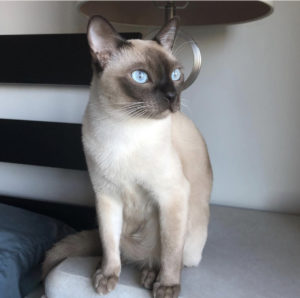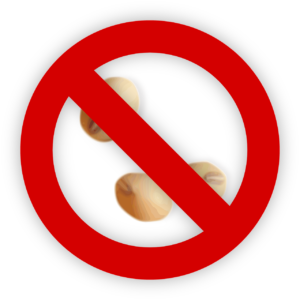Are There Carcinogenic Ingredients In Your Cat’s Food?

Photo credit: Coco
Cocotonkslife of Instagram
I got quite a surprise this week as I was analyzing some cat food products for a client. And it wasn’t a good surprise either. I found sodium nitrite along with several food colorings, which are known carcinogens. The cat I was helping doesn’t have cancer that I know of, but I’m certain his parents didn’t realize they are feeding him cat food with carcinogenic ingredients in it.
The number of cats and dogs being diagnosed with cancer has become the trend, an epidemic in fact. While there are many causes of cancer in pets, lifestyle is a huge contributor, and pet parents just aren’t aware. What we feed our cats makes up a large part of lifestyle considerations. Unbeknownst to pet parents, they are feeding their cats a daily dose of carcinogenic ingredients.
Carcinogenic ingredients in cat food
Cancer is the word that no cat parent wants to hear from their vet. It strikes fear into our hearts, taxes our pocketbooks, and robs our beloved kitties of a healthy, long life. One of the very best things you can do as a cat parent is to evaluate what your cat is eating.
No pet food manufacturer is going to put a warning like “Cancer-causing ingredients inside” on the outside of the bag. In fact, you won’t even read the word “carcinogenic” anywhere on the product. Despite how clever their marketing message is or how appealing the beautiful photos are on the package, don’t be fooled. What’s inside the package can often contain ingredients that create dis-ease in your pet’s body. When there is dis-ease the result is imbalance; organs and body systems are unable to function the way they are designed. Over time this results in chronic inflammation, organ and metabolic disfunction and even death if measures aren’t taken to restore the natural homeostasis (balance).
Cat food ingredients that cause cancer
You have to read the fine print on the pet food labels. Invest in a magnifying glass if necessary because sometimes the print is very small. Is this on purpose? Perhaps. Either way, I think many manufacturers hope you will never read the ingredients label. And if you do read it, they hope you won’t question it. Nonetheless, I want to give you a list of ingredients to look for that hide a dirty little secret: they cause cancer!
Advanced glycation end products
Processed pet food is, by nature, cooked at extremely high temperatures resulting in advanced glycation end products. Rendered ingredients like meat by-products and meat meals, along with starchy ingredients like corn, legumes, wheat, rice, soy, and potatoes are heated to extremely high ingredients several times in the manufacturing process.
AGEs are the chemical by-products resulting from heating proteins and carbohydrates to extremely high temperatures. Specifically, heterocyclic amines result from cooking proteins and acrylamides result from cooking sugars at high temperatures. The FDA acknowledges there is a risk of eating such foods on its website:
Acrylamide caused cancer in animals in studies where animals were exposed to acrylamide at very high doses. In 2010, the Joint Food and Agriculture Organization/World Health Organization Expert Committee on Food Additives (JECFA) concluded that acrylamide is a human health concern, and suggested additional long-term studies.
Heterocyclic amines were analyzed in this article by the National Institute of Health, too. As a result, “it is hypothesized that there is a connection between dietary heterocyclic amines and cancer in animals consuming these foods.”

Chemical preservatives
In order to preserve shelf life of dry food manufacturers must use preservatives; without them fats will go rancid. Even canned food requires some kind of preservative. Food additives serving as preservatives are not harmless, and it’s surprising that despite knowing they are harmful I still find them listed on pet food labels. You’ll want to avoid the following preservatives as they are extremely toxic and cancer causing:
- BHA–butylated hydroxyanisole
- BHT–butylated hydroxytoluene
- Propyl Gallate
- Ethoxyquin–found in imported fish meal, hidden under a label of “natural preservatives”
- Sodium nitrite/nitrate
- TBHQ–Tertiary butylhydroquinone
Food colors and dyes are carcinogenic ingredients
Colors and dyes are commonly used in pet foods, especially kibble, to make the food different colors. These colors are designed to appeal to the pet parent; cats don’t care about colors because they can’t always distinguish them. These dyes are linked to serious disease, including cancer.
The National Institute of Health published a toxicology review in 2012 of food colorings and dyes. “Food dyes, synthesized originally from coal tar and now petroleum, have long been controversial because of safety concerns. Many dyes have been banned because of their adverse effects on laboratory animals or inadequate testing.”
The toxicology review states: Red 3 causes cancer in animals, and there is evidence that several other dyes also are carcinogenic. Three dyes (Red 40, Yellow 5, and Yellow 6) have been found to be contaminated with benzidine or other carcinogens.
Carcinogenic food colors
An article in The Truth About Pet Food stated findings from the CSPI (The Center for Science in the Public Interest) regarding the use of dyes in foods. Of the common food dyes found in pet foods and treats, the CSPI summary states…
“Blue 2 cannot be considered safe given the statistically significant incidence of tumors, particularly brain gliomas, in male rats. It should not be used in foods.”
“Yellow 5 was not carcinogenic in rats, but was not adequately tested in mice. It may be contaminated with several cancer-causing chemicals. In addition, Yellow 5 causes sometimes-severe hypersensitivity reactions in a small number of people and might trigger hyperactivity reactions in a small number of people and might trigger hyperactivity and other behavior effects in children. Posing some risks, while serving no nutritional or safety purpose, Yellow 5 should not be allowed in foods.”
“Yellow 6 caused adrenal tumors in animals, though that is disputed by industry and the FDA. It may be contaminated with cancer-causing chemicals and occasionally causes severe hypersensitivity reactions. Yellow 6 adds an unnecessary risk to the food supply.”
GMOs, known carcinogens
Pet food manufacturers like to use cheap GMO ingredients as meat substitutes, fillers, and omega 6 fats which keeps their profit margins higher. The most common genetically modified foods grown today are corn, soy, alfalfa, canola, and sugar beets. All of these ingredients are commonly found in pet food, but they won’t be labeled as GMOs.
Furthermore, the glyphosate pesticide sprayed on GMO crops has been proven to cause cancer, only adding to the toxicity and risk of feeding GMO ingredients in pet food. Unfortunately glyphosate is not destroyed in the manufacturing process. Lab tests are finding traces of glyphosate residues in pets are 50% greater than residues in humans.
Aflatoxins and mycotoxins
Grains used in pet foods can contain toxic, deadly molds called aflatoxins and mycotoxins. According to an article by Dr. Karen Becker, DVM,, “Aflatoxins are naturally-occurring mycotoxins produced by the Aspergillus flavus and Aspergillus paraciticus species of fungi that grow on certain crops. Aflatoxins are highly carcinogenic. They poison the liver and promote tumor development.”
Even the FDA website confirms this:
“Aflatoxins are toxic by-products of mold growth on certain agricultural commodities. Since their discovery in the early 1960’s, aflatoxins have been shown to be carcinogenic to laboratory test animals.”
Mycotoxins are just as deadly according to this article by Susan Thixton of Truth About Pet Food. “…existing studies of mycotoxin contamination in pet food overlook the day to day consumption of small amounts of mycotoxins; resulting in “chronic diseases such as liver and kidney fibrosis, infections resulting from immonosuppression and cancer.” Grains associated with mycotoxins are corn, wheat, barley, and oats, so it’s best to avoid these.
Toxic metals
Did you also know that processed pet food may contain toxic heavy metals? There was a study done in 2010 by SpecCertiPrep, a laboratory standards company, who tested pet food and found some alarming results.
The abstract states the dilemma of pet owners very clearly. “The quality of many of the ingredients used for pet food is often considered to be inferior or unfit for human consumption. “Premium” brands claim to have superior ingredients and quality. Claims of the quality of premium ingredients do not offer data as to the potential toxicity of elements which may be found in those ingredients. The purpose of our study was to examine pet foods from various sources to determine if they contained potentially toxic elements and if high quality ingredients equated to less toxic elements present in the food.”
In the end several toxic heavy metals that are known carcinogens were discovered in shocking amounts in the foods tested. These included beryllium, cobalt, nickel, thorium, thallium. And you won’t find these on the label either.
Toxic load from carcinogenic ingredients
Without a doubt, carcinogenic ingredients are prevalent in processed pet food. When you consider the toxic load accumulation from years of eating carcinogens, there can be no great surprise that cats can end up with cancer. You must start examining your cat’s food label so that you are not deceived into believing the marketing hype on the front of the bag or in pet food commercials. Educate yourself so that you can make the best decisions possible when it comes to feeding your cat.
Cats are carnivores and need a high quality, meat-based diet; they have no nutritional need for carbohydrates or starches. Feeding a species appropriate diet with as little processing as possible will be your best bet to ensure a longer, healthier life! To learn more about optimal nutrition for your cat, hop over to this page.


